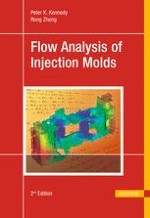2013 | OriginalPaper | Buchkapitel
Improved Fiber Orientation Modeling
verfasst von : Peter Kennedy, Rong Zheng
Erschienen in: Flow Analysis of Injection Molds
Verlag: Carl Hanser Verlag GmbH & Co. KG
Aktivieren Sie unsere intelligente Suche, um passende Fachinhalte oder Patente zu finden.
Wählen Sie Textabschnitte aus um mit Künstlicher Intelligenz passenden Patente zu finden. powered by
Markieren Sie Textabschnitte, um KI-gestützt weitere passende Inhalte zu finden. powered by
Many simulations for predicting orientation in short-fiber reinforced thermoplastics adopt the Folgar-Tucker model [122], which was described in Chapter 5. The Folgar-Tucker model adds into the Jeffery equation an isotropic rotary diffusion term to account for fiber-fiber interactions. The diffusivity is assumed to be proportional to the generalized shear rate, which is believed to be a valid assumption. However, the model delegates the strength of fiber-fiber interactions to just a single scalar constant, or the coefficient of interaction CI, which is used as a fitting parameter. Since there is no fundamental basis to determine the value of CI, Tucker and his co-workers find the value of CI> by adjusting it to match the experimentallymeasured fiber orientation tensor component a11. There is, however, no guarantee for other components to match the experimental data at the same time. Since the fiber orientation is influenced by several factors, the diffusivity may be, on occasion, used inappropriately to correct errors due to other factors. Furthermore, as mentioned previously, closure approximations have to be used to relate the fourth-order tensor to the second-order one. The CI value has also been found to vary significantly with different closure approximation schemes (Cintra and Tucker [62]).
